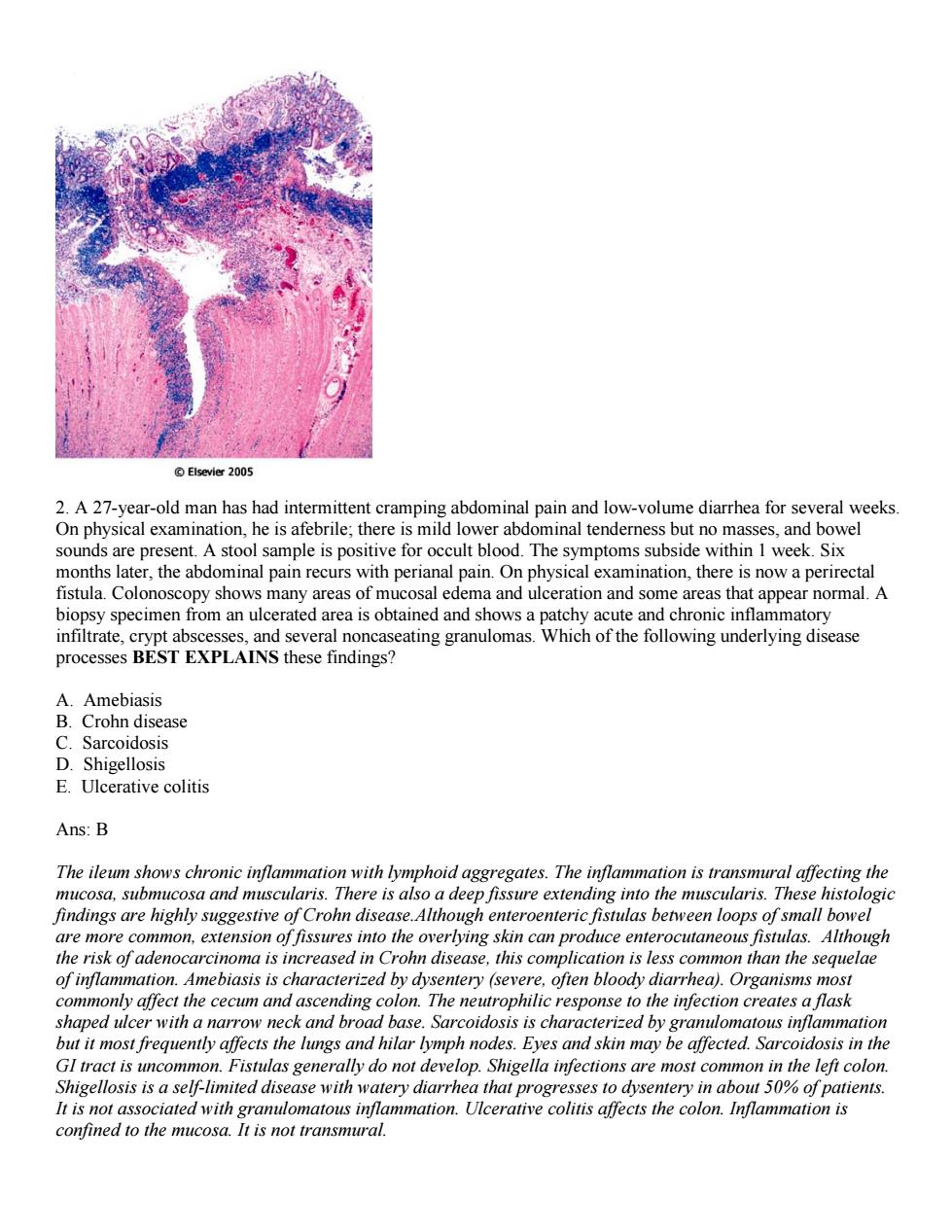正在加载图片...

Elsevier 2005 2.A27-yea-ld man has had for several weeks On physical examination,he is afebrile;there is mild lower abdominal tenderness but no masses,and bowel sounds are present.A stool sample is positive for occult blood.The symptoms subside within I week.Six months later,the abdominal pain recurs with perianal pain.On physical examination,there is now a perirectal fistula.Colonoscopy shows many areas of mucosal edema and ulceration and some areas that appear normal.A biopsy specimen from an ulcerated area is obtained and shows a patchy acute and chronic inflammatory infiltrate,crypt abscesses,and several noncaseating granulomas.Which of the following underlying disease processes BEST EXPLAINS these findings? A.Amebiasis B.Crohn disease C.Sarcoidosis D.Shigellosis E.Ulcerative colitis Ans:B The ileum shows chronic inflamm ation with lymphoid aggregates.The inflam the There is als roenteric oops of smal are more common.extension of fissures into the overlying s in can produce enterocutaneous fistulas.Although the risk of adenocarcinoma is increased in Crohn disease,this complication is less common than the sequelae of inflammation.Amebiasis is characterized by dysentery (severe,ofien bloody diarrhea).Organisms most commonly affect the cecum and ascending colon.The neutrophilic response to the infection creates a flask shaped ulcer with a narrow neck and broad base.Sarcoidosis is characterized by granulomatous inflammation but it most frequently affects the lungs and hilar lymph nodes.Eyes and skin may be affected.Sarcoidosis in the GI tract is uncommon.Fistulas generally do not develop.Shigella infections are most common in the left colon. Shigellosis is a self-limited disease with watery diarrhea that progresses to dysentery in about 50%of patients. It is not associated with granulomatous inflammation.Ulcerative colitis affects the colon.Inflammation is confined to the mucosa.It is not transmural.2. A 27-year-old man has had intermittent cramping abdominal pain and low-volume diarrhea for several weeks. On physical examination, he is afebrile; there is mild lower abdominal tenderness but no masses, and bowel sounds are present. A stool sample is positive for occult blood. The symptoms subside within 1 week. Six months later, the abdominal pain recurs with perianal pain. On physical examination, there is now a perirectal fistula. Colonoscopy shows many areas of mucosal edema and ulceration and some areas that appear normal. A biopsy specimen from an ulcerated area is obtained and shows a patchy acute and chronic inflammatory infiltrate, crypt abscesses, and several noncaseating granulomas. Which of the following underlying disease processes BEST EXPLAINS these findings? A. Amebiasis B. Crohn disease C. Sarcoidosis D. Shigellosis E. Ulcerative colitis Ans: B The ileum shows chronic inflammation with lymphoid aggregates. The inflammation is transmural affecting the mucosa, submucosa and muscularis. There is also a deep fissure extending into the muscularis. These histologic findings are highly suggestive of Crohn disease.Although enteroenteric fistulas between loops of small bowel are more common, extension of fissures into the overlying skin can produce enterocutaneous fistulas. Although the risk of adenocarcinoma is increased in Crohn disease, this complication is less common than the sequelae of inflammation. Amebiasis is characterized by dysentery (severe, often bloody diarrhea). Organisms most commonly affect the cecum and ascending colon. The neutrophilic response to the infection creates a flask shaped ulcer with a narrow neck and broad base. Sarcoidosis is characterized by granulomatous inflammation but it most frequently affects the lungs and hilar lymph nodes. Eyes and skin may be affected. Sarcoidosis in the GI tract is uncommon. Fistulas generally do not develop. Shigella infections are most common in the left colon. Shigellosis is a self-limited disease with watery diarrhea that progresses to dysentery in about 50% of patients. It is not associated with granulomatous inflammation. Ulcerative colitis affects the colon. Inflammation is confined to the mucosa. It is not transmural